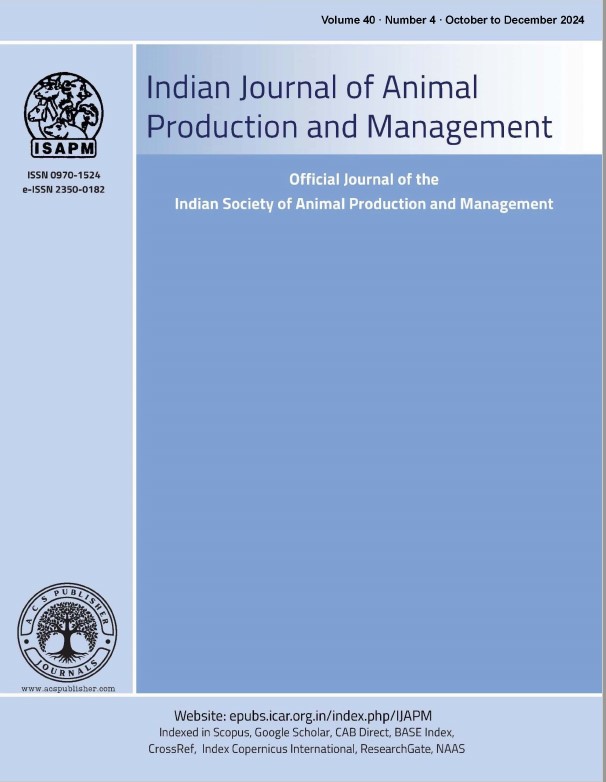Influence of High Milk Feeding Practices on Faecal Consistency Score and Behaviour of Early Weaned Crossbred Calves
DOI:
https://doi.org/10.48165/ijapm.2024.40.3.10Keywords:
high milk feeding, crossbred calves, faecal consistency, behaviourAbstract
This study investigated the impact of high milk feeding on the body weight of 25 early-weaned crossbred (HF×K) calves at Livestock Research Station, Kamdhenu University, Anand, Gujarat, over 182 days. Calves were divided into five treatment groups with equal numbers of male and female calves. Colostrum was provided for the first 3 days, followed by 4 liters of fresh milk daily for the first two weeks. The total milk quantity offered in T1, T2, T3, T4 and T5 was 252, 329, 353.5, 378, 402.5 kg respectively, to study the faecal consistency and behavior of calves. The faecal consistency and behaviour of calves after one hour during morning milk feeding was observed among the experimental calves for milk feeding of 63 days. The observation shown that calves of T5 group (higher quantity of milk feeding) defecate less normal faeces with incidences of water faeces. The calves of T5 group exhibited discomfort sign like; standing up/down, licking and kicking of abdomen after ingesting milk. The high quantity of milk feeding at a stretch (T5) caused behavior abnormality and loose faeces in calves. The feeding of high amount of (T5) is not advisable for the welfare and intestinal health of crossbred calves.
References
Abbasa, W., Shaukat, A., Bhattia, M. S., Khana, N. S., Hassan, M., Warriachc, P. W., & David, M. (2017). Effect of weaning age and milk feeding volume on growth performance of Nili-Ravi buffalo calves. Italian Journal of Animal Science,
(3), 490-499.
Appleby, M. C., Weary, D. M., & Chua, B. (2001). Performance and feeding behaviour of calves on ad libitum milk from artificial teats. Applied Animal Behaviour Science, 74(3), 191-201.
Arens, S. C., Sharpe, K. T., Schutz, M. M., & Heins, B. J. (2023). Response to ad libitum milk allowance by crossbred dairy and dairy–beef calves in an automated feeding system. Translational Animal Science, 7(1), 1-8. https://doi.org/10.1093/tas/txad063.
Borderas, T. F., de Passille, A. M. B., & Rushen, J. (2009). Feeding behavior of calves fed small or large amounts of milk. Journal of Dairy Science, 92, 2843-2852.
De Passillé, A. M. (2001). Sucking motivation and related problems in calves. Applied Animal Behaviour Science, 72(3), 175-187.
De Passillé, A. M., & Rushen, J. (2006). Calves’ behavior during and after feeding in an automatic milk feeder. Journal of Dairy Science, 89(10), 4218-4224.
Ellingsena, K., Mejdella, C. M., Ottesen, N., Larsenb, S., & Grondahl A. M. (2016). The effect of large milk meals on digestive physiology and behaviour in dairy calves. Physiology and Behaviour, 154, 169-174.
Fischer, A. J., Villot, C., Van Niekerk, J. K., Yohe, T. T., Renaud D. L., & Steele, M. A. (2019). Invited Review: Nutritional regulation of gut function in dairy calves: form colostrum to weaning. Applied Animal Science, 35: 498-510.
Kamalahasan, K., Sasikala, N., Sabin, G., Prakash, G., & Kumar, C. B. (2018). Economics of feeding milk replacers in crossbred calves. The Pharma Innovation Journal, 7, 322-324.
Khan, M. A., Lee, H. J., Lee, W. S., Kim, H. S., Ki, K. S., Hur, T. Y., & Choi, Y. J. (2007). Structural growth, rumen development, and metabolic and immune responses of Holstein male calves fed milk through step-down and conventional methods. Journal of Dairy Science, 90(7), 3376-
Khan, M. A., Weary, M. A. G., & Keyserlingk, V. (2011). Hay intake improves performance and rumen development of calves fed higher quantities of milk. Journal of Dairy science,
(7), 3547-3553.
Larson, L. L., Owen, F. G., Albright, J. L., Appleman, R. D. Lamb, R. C, & Muller, L. D. (1977). Guidelines toward more uniformity in
measuring and reporting calf experimental data. Journal of Dairy Science, 60, 989-991.
Patel, J. H. (2022). Performance of preweaned crossbred (HF x Kankrej) calves under different milk feeding methods and frequencies under intensive production system [Ph.D. Thesis, Kamdhenu University, Gandhinagar].
Singh, P., Kamboj, M. L., Chandra, S., Amit, N. (2019). Influence of weaning on growth, health and behavior of buffalo (Bubalus Bubalis) calves. Indian Journal of Animal Research, 53(5), 680-684.
Soberon, F., Raffrenato, E., Everett, R. W., & Van Amburgh, M. E. (2012). Preweaning milk replacer intake and effects on long-term productivity of dairy calves. Journal of Dairy Science, 95(2), 783-793.
Teschner, M., Czycholl, I., Krieter, J., & Schrader, L. (2019). Assessment of disbudding methods
and their impact on the behaviour and performance of dairy calves. Applied Animal Behaviour Science, 213, 23-30.
Uigley, J. D., Drewry, J. J., Martin, K. R., & Polo, J. (2006). Effects of a colostrum supplement on intake, body weight, and serum immunoglobulins in dairy calves. Journal of Dairy Science, 89(5), 2056-2065.
Uys. J. L., Lourens, D. C., & Thompson, P. N. (2011). The effect of unrestricted milk feeding on the growth and health of Jersey calves. Journal of the South African Veterinary Association.
(1), 47-52.
Yavuz, E., Todorov, N., Ganchev, G., & Nedelkov, K. (2015). The effect of feeding different milk programs on dairy calf growth, health and development. Bulgarian Journal of Agricultural Science, 21(2), 384-393.

